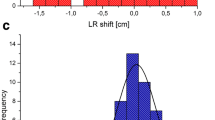Abstract
It is often assumed that radiation-induced secondary cancer after proton therapy forms preferentially close to the distal fall-off of the spread-out Bragg peak because of an increased relative biological effectiveness (RBE) with regard to cancer induction of low-energy protons. In this study we analyze to what extent dose gradients distal to the Planning Target Volume (PTV) may, independently from the RBE, contribute to enhanced radiation carcinogenesis. The study is based on two dogs which, out of 30 dogs treated with proton therapy at the Paul Scherrer Institute (PSI), developed a secondary cancer. Both dogs were originally diagnosed and treated for a fibrosarcoma and developed an osteosarcoma 48 and almost 60 months, respectively, after radiotherapy. From the dose distributions of the initial radiotherapy for both dogs three-dimensional maps of secondary cancer complication probability (SCCP) were computed. The SCCP maps were analyzed in the regions where the dogs developed a secondary cancer. The SCCP maps showed an enhanced risk in the regions of the femur where the secondary cancers were detected, as compared to the SCCP of the total femur. Excess risk of radiation-induced cancer at the distal part of proton radiation fields can thus be explained using SCCP calculations on the basis of the physical dose distributions. Therefore, the occurrence of secondary cancer close to the distal dose gradients of proton therapy is not necessarily due to an increased RBE of low-energy protons. More extensive studies based on more patients will be necessary to further elucidate the factors influencing the development of secondary tumors.


Similar content being viewed by others
References
Paganetti H, Niemierko A, Ancukiewicz M, Gerweck LE, Goitein M, Loeffler JS, Suit HD (2002) Relative biological effectiveness (RBE) values for proton beam therapy. Int J Radiat Oncol Biol Phys 53:407–421
Pedroni E, Bacher R, Blattmann H, Boehringer T, Coray A, Lomax A, Lin S, Munkel G, Scheib S, Schneider U, Tourovsky A (1995) The 200 MeV proton therapy project of PSI: conceptual design and practical realization. Med Phys 22:37–53
Edwards AA (2001) RBE of radiations in space and the implications for space travel. Phys Med 17(Suppl 1):147–152
Belli M, Cera F, Cherubini R, Dalla Vecchia M, Haque AM, Ianzini F, Meschini G, Sapora O, Simone G, Tabocchini MA, Tiveron P (1998) RBE-LET relationships for cell inactivation and mutation induced by low energy protons in V79 cells: further results at the LNL facility. Int J Radiat Biol 74:501–509
Dörr W, Herrmann T (2002) Second primary tumors after radiotherapy for malignancies. Treatment-related parameters. Strahlenther Onkol 178:357–362
Kaser-Hotz B (1995) Animal models for radiotherapy. In: Linz U (ed) Ion beams in tumor therapy. Chapman & Hall, Weinheim Deutschland, pp 83–91
Schneider U, Zwahlen D, Ross D, Kaser-Hotz B (2005) Estimation of radiation induced cancer from 3D-dose distributions: concept of organ equivalent dose. Int J Radiat Oncol Biol Phys 61:1510–1515
Schneider U, Kaser-Hotz B (2005) Radiation risk estimates after radiotherapy: application of the organ equivalent dose concept to plateau dose–response relationships. Radiat Environ Biophys 44:235–239
Hall EJ, Wuu CS (2003) Radiation-induced second cancers: the impact of 3D-CRT and IMRT. Int J Radiat Oncol Biol Phys 56:83–88
McEntee MC, Page RL, Theon A, Erb HN, Thrall DE (2004) Malignant tumor formation in dogs previously irradiated for acanthomatous epulis. Vet Radiol Ultrasound 45:357–361
Priester WA, McKay FW (1980) The occurrence of tumors in domestic animals. Natl Cancer Inst Monogr 54:1–210
Withrow SJ, Powers BE, Straw RC, Wilkins RM (1991) Comparative aspects of osteosarcoma. Dog versus man. Clin Orthop Relat Res 270:159–168
Dernell WS, Withrow SJ (2001) Tumors of the skeletal system. In: Small animal clinical oncology. WB Saunders, Philadelphia, pp 378–417
Bennett D, Campbell JR, Brown P (1979) Osteosarcoma associated with healed fractures. J Small Anim Pract 20:13–18
Sinibaldi K, Rosen H, Liu SK, DeAngelis M (1976) Tumors associated with metallic implants in animals. Clin Orthop Relat Res 118:257–266
Stevenson S (1991) Fracture-associated sarcomas. Vet Clin North Am Small Anim Pract 21:859–872
Gillette SM, Gillette EL, Powers BE, Withrow SJ (1990) Radiation-induced osteosarcoma in dogs after external beam or intraoperative radiation therapy. Cancer Res 50:54–57
Author information
Authors and Affiliations
Corresponding author
Rights and permissions
About this article
Cite this article
Schneider, U., Lomax, A., Hauser, B. et al. Is the risk for secondary cancers after proton therapy enhanced distal to the Planning Target Volume? A two-case report with possible explanations. Radiat Environ Biophys 45, 39–43 (2006). https://doi.org/10.1007/s00411-006-0034-7
Received:
Accepted:
Published:
Issue Date:
DOI: https://doi.org/10.1007/s00411-006-0034-7




